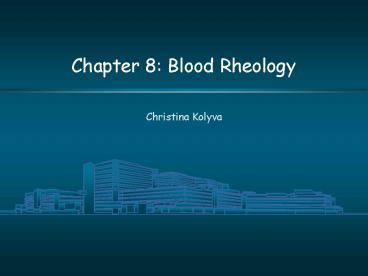Chapter 8: Blood Rheology - PowerPoint PPT Presentation
1 / 24
Title:
Chapter 8: Blood Rheology
Description:
Whole blood consists of formed elements and plasma ... Important for blood clotting.Fit forms fibrin, which is the network for a blood clot ... – PowerPoint PPT presentation
Number of Views:183
Avg rating:5.0/5.0
Title: Chapter 8: Blood Rheology
1
Chapter 8 Blood Rheology
- Christina Kolyva
2
Blood Composition
- Whole blood consists of formed elements and
plasma - Formed elements Red blood cells (RBCs) or
erhythrocytes (99.9) - White blood cells (WBCs) or leukocytes
- Platelets
- Plasma consists of Water (92)
- Plasma proteins (7)
- Other solutes (1)
- Hematocrit (H) is the percentage of whole blood
- occupied by cellular elements
3
Red Blood Cells
- In adult males 1 µl of whole blood contains
4.5-6.3 billion RBCs - Shape Biconcave disk-thin central region and
thick outer margin. Why? - Composition Only organelles related to
transport of respiratory gases - Hemoglobin (Hb) accounts for 95 of the cells
intracellular proteins - Function
- Production No nuclei or ribosomes, so they
cannot divide or produce their own proteins.
Life span 120 days - RBC formation (erythropoiesis) occurs in red
bone marrow
4
White Blood Cells
- In adults 1 µl of whole blood contains 6-9
thousand WBCs - Shape Divided to granulocytes and agranulocytes
- Composition They do have a nucleus
- They contain vesicles and lysosomes
- Function Defend the body against invasion by
pathogens - Remove toxins, waste, abnormal or damaged cells
- Production They survive from days (N) to months
or years (L) - Produced in the bone marrow
- Ls also produced in lymphoid tissues
5
Platelets
- In adults 1 µl of whole blood contains 150-500
thousand platelets - Shape Flattened disks, round when viewed from
above - Composition They do not have a nucleus
- They carry enzymes and other substances
important for the process of blood clotting - Function Transport chemicals for initiation and
control of clotting - Form temporary platelet plug in the walls of
injured blood vessels - Actively contract when the clot has been formed
- Production They live for 9-12 days
- Produced in the bone marrow by magakaryocytes
6
Plasma
- Composition Contains significant quantities of
dissolved proteins - Albumins (60) Important for the transport
of fatty acids, thyroid hormones and steroid
hormones. Also major contributors to the
osmotic pressure of plasma - Globulins (35) Antibodies and transport
proteins - Fibrinogen Important for blood clotting.Fit
forms fibrin, which is the network for a
blood clot - Also contains regulatory proteins,
electrolytes, organic nutrients and organic
waste
7
Viscosity
- Viscosity µ
- Units cP ( )
8
Newtonian, Non-Newtonian behaviour
Rheological curves shear stress-shear rate
curves
- Bingham fluids (2)
- Casson fluids (3)
- Pseudoplastics (4, 5)
9
Apparent viscosity
- For non-newtonian fluids apparent viscosity µa
is defined as the slope of the rheological curve
at a specific shear rate - Relative apparent viscosity is the ratio of the
apparent viscosity of a solution divided by the
apparent viscosity of the solvent
10
Viscometers
11
Blood viscosity
- Blood is a non-Newtonian fluid
- Apparent blood viscosity depends on shear rate
- Low shear rategt Rouleaux formations and
sedimentationgthigh apparent viscosity - High shear rategt the stacks break downgt
newtonian behaviour
12
Blood viscosity
- The blood has yield stress
- Yield stress depends on H and also on the
fibrinogen concentration in plasma - Empirical relation
13
Blood viscosity
- Relative viscosity depends also on H and on the
flexibility of the RBCs
14
Blood viscosity
- The dependence on H is non-linear for tube sizes
down to 9 µm. For smaller tubes the relation is
linear
15
Blood viscosity
- Blood viscosity depends on plasma viscosity .
The latter depends on the protein concentration
of plasma - Protein concentration of plasma also affects the
flexibility of the RBCs and the interactions
between them (adhesiveness, aggregation)
16
Blood viscosity
- Blood viscosity also depends on temperature, on
the presence of platelets (thrombi formation)
and on the presence of WBCs (but only at
pathological conditions) - Conclusion? The parameters that determine plasma
viscosity affect also each other. It is
difficult to study each one separately
17
Model
- Blood is modeled as a Casson fluid
- When tgtgtt0 k µa and blood behaves like a
newtonian fluid - At high shear rates µa can be calculated as
18
Fahraeus-Lindqvist effect
- The apparent viscosity of blood depends on the
geometry of the instrument in which it is
measured
19
Fahraeus effect
- Reduction in tube hematocrit in microvessels
relative to the supply hematocrit
20
Blood rheology in the circulation
- High shear rates, therefore blood can be
considered newtonian - In the capillaries though, the
Fahraeus-Lindqvist effect must be taken into
account
21
Blood rheology in the circulation
- Isolated rat hearts-blood apparent viscosity was
changes by adding albumin - Minimal resistance remained constant despite the
changes in apparent viscosity
22
Blood rheology in the circulation
- Surface of endothelial cells is lined with
glycocalyx
23
Blood rheology in the circulation
- Consists of membrane-bound molecules
glycoproteins, glycolipids, proteoglycans and
proteins
24
Blood rheology in the circulation
- Implications of glycocalyx in blood rheology
- Decrease in H larger than predicted by the
anatomical diameter - Increased resistance to flow
- Shear stress on the endothelial surface is
small-transmitted via the glycocalyx - Regulation of blood flow via changing the shape
of the layer































